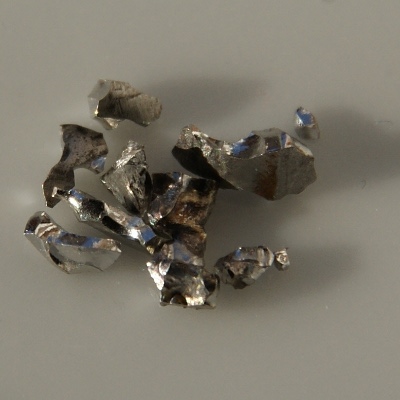Periodic Table Element Comparison: Compare Elements - Zinc vs Iridium
Compare Zinc and Iridium
Compare Zinc and Iridium on the basis of their properties, attributes and periodic table facts. Compare elements on more than 90 properties. All the elements of similar categories show a lot of similarities and differences in their chemical, atomic, physical properties and uses. These similarities and dissimilarities should be known while we study periodic table elements. You can study the detailed comparison between Zinc vs Iridium with most reliable information about their properties, attributes, facts, uses etc. You can compare Zn vs Ir on more than 90 properties like electronegativity , oxidation state, atomic shells, orbital structure, Electronaffinity, physical states, electrical conductivity and many more.
Facts
| Name | Zinc | Iridium |
| Atomic Number | 30 | 77 |
| Atomic Symbol | Zn | Ir |
| Atomic Weight | 65.409 | 192.217 |
| Phase at STP | Solid | Solid |
| Color | SlateGray | Silver |
| Metallic Classification | Transition Metal | Transition Metal |
| Group in Periodic Table | group 12 | group 9 |
| Group Name | zinc family | cobalt family |
| Period in Periodic Table | period 4 | period 6 |
| Block in Periodic Table | d -block | d -block |
| Electronic Configuration | [Ar] 3d10 4s2 | [Xe] 4f14 5d7 6s2 |
| Electronic Shell Structure (Electrons per shell) | 2, 8, 18, 2 | 2, 8, 18, 32, 15, 2 |
| Melting Point | 692.68 K | 2739 K |
| Boiling Point | 1180 K | 4701 K |
| CAS Number | CAS7440-66-6 | CAS7439-88-5 |
| Neighborhood Elements | Neighborhood Elements of Zinc | Neighborhood Elements of Iridium |
History
| Name | Zinc | Iridium |
| History | The element Zinc was discovered by Indian metallurgists in year Before 1000 BCE in Germany. Zinc derived its name from the German word Zink. | The element Iridium was discovered by S. Tennant in year 1803 in France and United Kingdom. Iridium derived its name from Iris, the Greek goddess of the rainbow. |
| Discovery | Indian metallurgists (Before 1000 BCE) | S. Tennant (1803) |
| Isolated | Indian subcontinent (1000 BCE) | S. Tennant (1803) |
Presence: Abundance in Nature and Around Us
Parts per billion (ppb) by weight / by atoms (1ppb =10^-7 %)
| Name | Zinc | Iridium |
| Abundance in Universe | 300 / 6 | 2 / 0.01 |
| Abundance in Sun | 2000 / 30 | 2 / 0.01 |
| Abundance in Meteorites | 180000 / 44000 | 550 / 60 |
| Abundance in Earth's Crust | 79000 / 25000 | 0.4 / 0.05 |
| Abundance in Oceans | 5 / 0.47 | - / - |
| Abundance in Humans | 33000 / 3200 | - / - |
Crystal Structure and Atomic Structure
| Name | Zinc | Iridium |
| Atomic Volume | 9.161 cm3/mol | 8.5203 cm3/mol |
| Atomic Radius | 142 pm | 180 pm |
| Covalent Radius | 131 pm | 137 pm |
| Van der Waals Radius | 139 pm | - |
| Atomic Spectrum - Spectral Lines | ||
| Emission Spectrum |  |  |
| Absorption Spectrum |  |  |
| Lattice Constant | 266.49, 266.49, 494.68 pm | 383.9, 383.9, 383.9 pm |
| Lattice Angle | π/2, π/2, 2 π/3 | π/2, π/2, π/2 |
| Space Group Name | P63/mmc | Fm_ 3m |
| Space Group Number | 194 | 225 |
| Crystal Structure | Simple Hexagonal 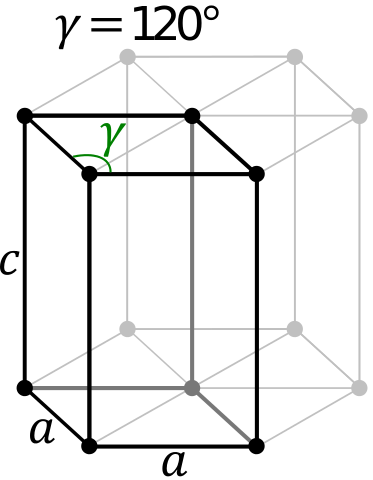 | Face Centered Cubic 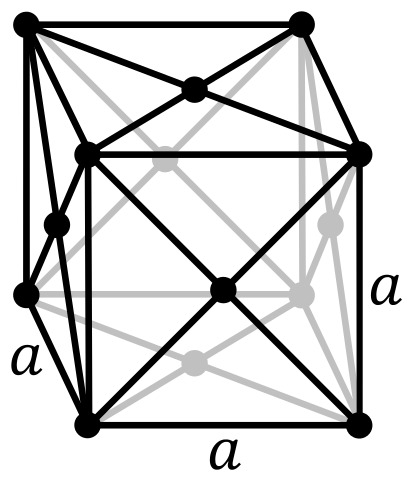 |
Atomic and Orbital Properties
| Name | Zinc | Iridium |
| Atomic Number | 30 | 77 |
| Number of Electrons (with no charge) | 30 | 77 |
| Number of Protons | 30 | 77 |
| Mass Number | 65.409 | 192.217 |
| Number of Neutrons | 35 | 115 |
| Shell structure (Electrons per energy level) | 2, 8, 18, 2 | 2, 8, 18, 32, 15, 2 |
| Electron Configuration | [Ar] 3d10 4s2 | [Xe] 4f14 5d7 6s2 |
| Valence Electrons | 3d10 4s2 | 5d7 6s2 |
| Oxidation State | 2 | 3, 4 |
| Atomic Term Symbol (Quantum Numbers) | 1S0 | 4F9/2 |
| Shell structure | 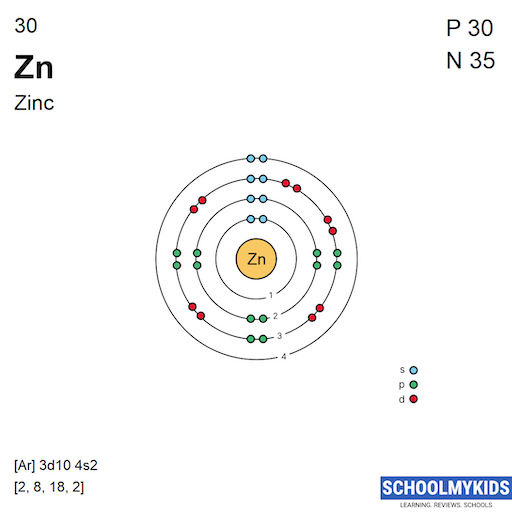 | 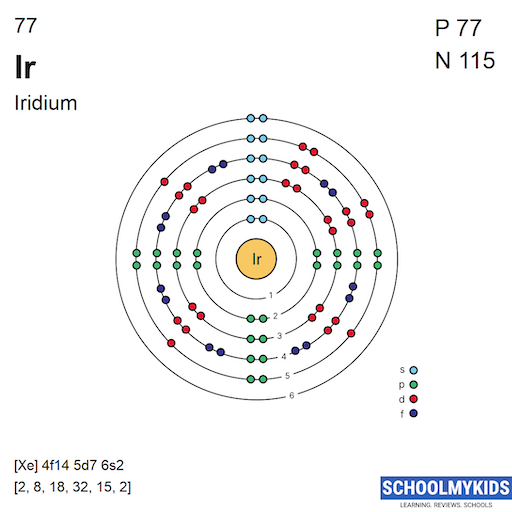 |
Isotopes and Nuclear Properties
Zinc has 5 stable naturally occuring isotopes while Iridium has 2 stable naturally occuring isotopes.
| Name | Zinc | Iridium |
| Known Isotopes | 54Zn, 55Zn, 56Zn, 57Zn, 58Zn, 59Zn, 60Zn, 61Zn, 62Zn, 63Zn, 64Zn, 65Zn, 66Zn, 67Zn, 68Zn, 69Zn, 70Zn, 71Zn, 72Zn, 73Zn, 74Zn, 75Zn, 76Zn, 77Zn, 78Zn, 79Zn, 80Zn, 81Zn, 82Zn, 83Zn | 164Ir, 165Ir, 166Ir, 167Ir, 168Ir, 169Ir, 170Ir, 171Ir, 172Ir, 173Ir, 174Ir, 175Ir, 176Ir, 177Ir, 178Ir, 179Ir, 180Ir, 181Ir, 182Ir, 183Ir, 184Ir, 185Ir, 186Ir, 187Ir, 188Ir, 189Ir, 190Ir, 191Ir, 192Ir, 193Ir, 194Ir, 195Ir, 196Ir, 197Ir, 198Ir, 199Ir |
| Stable Isotopes | Naturally occurring stable isotopes: 64Zn, 66Zn, 67Zn, 68Zn, 70Zn | Naturally occurring stable isotopes: 191Ir, 193Ir |
| Neutron Cross Section | 1.1 | 425 |
| Neutron Mass Absorption | 0.00055 | 0.08 |
Chemical Properties: Ionization Energies and electron affinity
| Name | Zinc | Iridium |
| Valence or Valency | 2 | 6 |
| Electronegativity | 1.65 Pauling Scale | 2.2 Pauling Scale |
| Electron Affinity | 0 kJ/mol | 151 kJ/mol |
| Ionization Energies | 1st: 906.4 kJ/mol 2nd: 1733.3 kJ/mol 3rd: 3833 kJ/mol 4th: 5731 kJ/mol 5th: 7970 kJ/mol 6th: 10400 kJ/mol 7th: 12900 kJ/mol 8th: 16800 kJ/mol 9th: 19600 kJ/mol 10th: 23000 kJ/mol 11th: 26400 kJ/mol 12th: 29990 kJ/mol 13th: 40490 kJ/mol 14th: 43800 kJ/mol 15th: 47300 kJ/mol 16th: 52300 kJ/mol 17th: 55900 kJ/mol 18th: 59700 kJ/mol 19th: 67300 kJ/mol 20th: 71200 kJ/mol 21st: 179100 kJ/mol | 1st: 880 kJ/mol 2nd: 1600 kJ/mol |
Physical Properties
| Name | Zinc | Iridium |
| Density | 7.14 g/cm3 | 22.56 g/cm3 |
| Molar Volume | 9.161 cm3/mol | 8.5203 cm3/mol |
Elastic Properties | ||
| Young Modulus | 108 | 528 |
| Shear Modulus | 43 GPa | 210 GPa |
| Bulk Modulus | 70 GPa | 320 GPa |
| Poisson Ratio | 0.25 | 0.26 |
Hardness - Tests to Measure of Hardness of Element | ||
| Mohs Hardness | 2.5 MPa | 6.5 MPa |
| Vickers Hardness | - | 1760 MPa |
| Brinell Hardness | 412 MPa | 1670 MPa |
Electrical Properties | ||
| Electrical Conductivity | 17000000 S/m | 21000000 S/m |
| Resistivity | 5.9e-8 m Ω | 4.7e-8 m Ω |
| Superconducting Point | 0.85 | 0.11 |
Heat and Conduction Properties | ||
| Thermal Conductivity | 120 W/(m K) | 150 W/(m K) |
| Thermal Expansion | 0.0000302 /K | 0.0000064 /K |
Magnetic Properties | ||
| Magnetic Type | Diamagnetic | Paramagnetic |
| Curie Point | - | - |
| Mass Magnetic Susceptibility | -2.21e-9 m3/kg | 1.67e-9 m3/kg |
| Molar Magnetic Susceptibility | -1.45e-10 m3/mol | 3.21e-10 m3/mol |
| Volume Magnetic Susceptibility | -0.0000158 | 0.0000377 |
Optical Properties | ||
| Refractive Index | 1.00205 | - |
Acoustic Properties | ||
| Speed of Sound | 3700 m/s | 4825 m/s |
Thermal Properties - Enthalpies and thermodynamics
| Name | Zinc | Iridium |
| Melting Point | 692.68 K | 2739 K |
| Boiling Point | 1180 K | 4701 K |
| Critical Temperature | - | - |
| Superconducting Point | 0.85 | 0.11 |
Enthalpies | ||
| Heat of Fusion | 7.35 kJ/mol | 26 kJ/mol |
| Heat of Vaporization | 119 kJ/mol | 560 kJ/mol |
| Heat of Combustion | - | - |
Regulatory and Health - Health and Safety Parameters and Guidelines
| Name | Zinc | Iridium |
| CAS Number | CAS7440-66-6 | CAS7439-88-5 |
| RTECS Number | RTECSZG8600000 | - |
| DOT Hazard Class | 4.3 | 4.1 |
| DOT Numbers | 1436 | 3089 |
| EU Number | - | - |
| NFPA Fire Rating | 0 | - |
| NFPA Health Rating | 2 | - |
| NFPA Reactivity Rating | 0 | - |
| NFPA Hazards | Water Reactive | - |
| AutoIgnition Point | 460 °C | - |
| Flashpoint | - | - |


